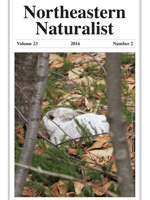In Pennsylvania, Lepus americanus (Snowshoe Hare) is near the southern limits of its range and at risk of range contraction because of loss of early-successional forest and impacts of climate change. We used hunter-harvest data to investigate changes in the distribution of Snowshoe Hare in Pennsylvania (1983–2011), forest inventory and land-use data to assess changes in amount and distribution of early-successional forest (1988–2011), and occupancy modeling (2004) to identify habitat and climate variables that explain the current distribution of Snowshoe Hare. We determined presence of Snowshoe Hare based on visual sightings, observations of tracks, and DNA analysis of fecal pellets, and used repeated visits to sampling sites and occupancy models to estimate occupancy rates (Ψ). Hunter-harvest data indicated the range of Snowshoe Hare in Pennsylvania contracted towards northwestern and northeastern portions of the state. Based on occupancy modeling, Snowshoe Hare were most likely to occupy early-successional and mixed deciduous—coniferous forest types and areas with colder winter temperatures, which coincided with the distribution of hunter harvests. Among the 4 forest types, we estimated Ψ = 0.52–0.79 and Ψ = 0.10–0.32 where winter temperatures were coldest and warmest, respectively. Total forest loss was <1% during 1988–2011, and the loss of early-successional forest in the current and former range of Snowshoe Hares was similar as were mean patch size and a fragmentation metric of early-successional habitat. Thus, changes in forest characteristics did not explain the range contraction we observed. We used climate-model predictions and our occupancy model to predict that average occupancy probability across northern Pennsylvania may decline from 0.27 in 2004 to 0.10–0.18 by 2050–2059, depending on the climate model. The range of Snowshoe Hare in Pennsylvania has contracted to regions of Pennsylvania with the coldest winter temperatures and most persistent snowpack, and based on projected climate change, our results suggest further range contraction of Snowshoe Hare in Pennsylvania.
How to translate text using browser tools
1 June 2016
Evidence for Range Contraction of Snowshoe Hare in Pennsylvania
Duane R. Diefenbach,
Stephen L. Rathbun,
Justin K. Vreeland,
Deborah Grove,
William J. Kanapaux
ACCESS THE FULL ARTICLE

Northeastern Naturalist
Vol. 23 • No. 2
June 2016
Vol. 23 • No. 2
June 2016




